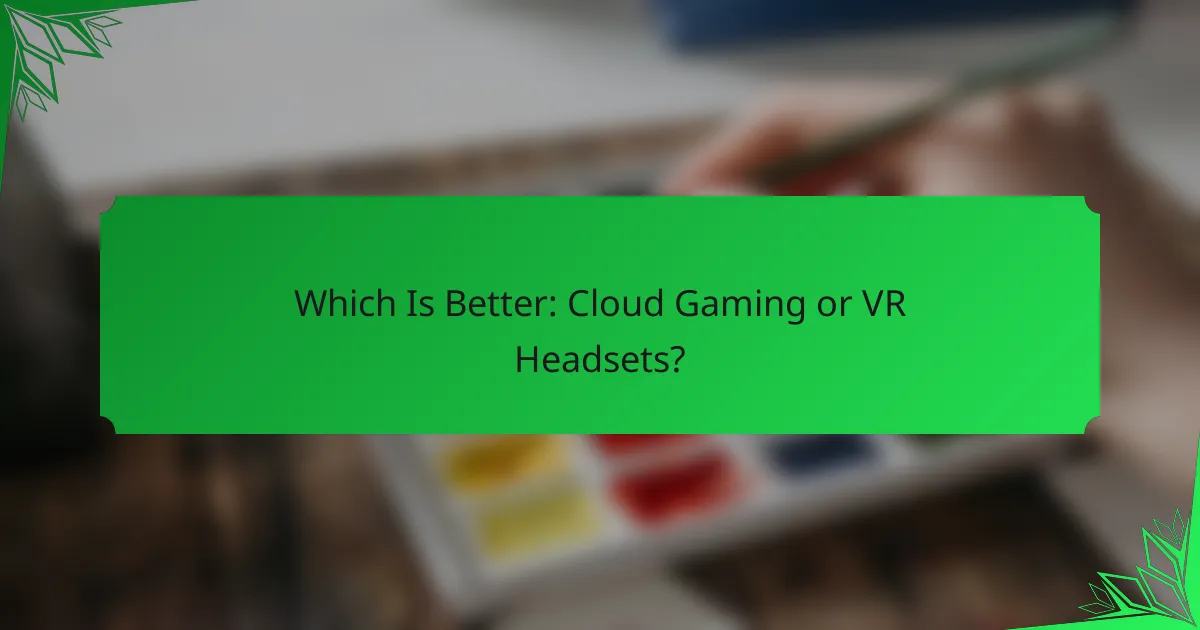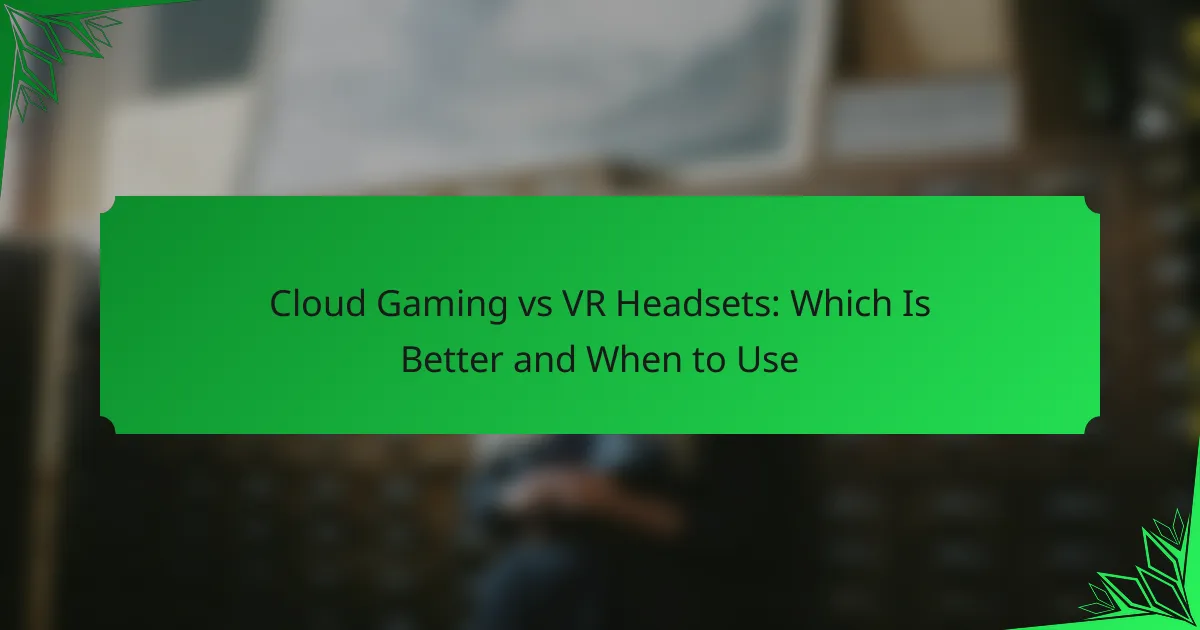As gaming technology evolves, players often find themselves choosing between cloud gaming and VR headsets, each offering distinct advantages. Cloud gaming provides flexibility and instant access to a wide range of titles without the need for expensive hardware, making it perfect for casual gamers. In contrast, VR headsets deliver unparalleled immersion, ideal for those seeking to engage deeply with virtual worlds and experiences. Ultimately, the choice depends on individual preferences and the type of gaming experience desired.

Which Is Better: Cloud Gaming or VR Headsets?
Cloud gaming is generally better for those seeking flexibility and accessibility, while VR headsets excel in delivering immersive experiences. The choice largely depends on personal preferences, gaming habits, and the specific experiences desired.
Cloud Gaming Offers Flexibility
Cloud gaming allows players to access a wide range of games on various devices without the need for powerful hardware. This means you can play on a smartphone, tablet, or low-end PC as long as you have a stable internet connection.
Services like NVIDIA GeForce NOW, Xbox Cloud Gaming, and PlayStation Now provide extensive libraries, enabling users to switch between games easily. This flexibility is ideal for casual gamers or those who travel frequently.
VR Headsets Provide Immersive Experiences
VR headsets, such as the Oculus Quest and HTC Vive, offer a level of immersion that cloud gaming cannot match. Users can experience games in a 360-degree environment, making gameplay feel more engaging and realistic.
This type of gaming is particularly suited for action, adventure, and simulation genres, where physical movement enhances the experience. However, VR setups often require dedicated space and can be more complex to set up.
Performance Depends on Internet Speed
The performance of cloud gaming is heavily reliant on your internet speed and stability. A minimum of 15 Mbps is typically recommended for a smooth experience, but faster speeds will yield better results, especially for high-resolution gaming.
In contrast, VR headsets run locally on your hardware, meaning performance is determined by the capabilities of your PC or console rather than your internet connection. This can lead to a more consistent experience, especially in environments with fluctuating internet speeds.
Cost Considerations for Each Option
Cloud gaming services often operate on a subscription model, with monthly fees ranging from around $10 to $30. This can be a cost-effective way to access multiple games without purchasing each title individually.
On the other hand, VR headsets can require a significant upfront investment, often costing several hundred dollars, plus the price of compatible hardware if needed. Consider your gaming frequency and budget when choosing between these options.

When Should You Use Cloud Gaming?
Cloud gaming is best suited for those who want instant access to games without the need for powerful hardware. It allows players to stream games directly from the cloud, making it a convenient option for casual gaming sessions.
Ideal for Casual Gamers
Cloud gaming is particularly appealing to casual gamers who may not want to invest heavily in gaming consoles or PCs. It enables quick play sessions without the commitment of purchasing expensive equipment or games.
For instance, platforms like NVIDIA GeForce NOW or Google Stadia allow players to jump into games from various devices, making it easy to enjoy gaming during short breaks or while traveling.
Best for Multi-Platform Access
One of the key advantages of cloud gaming is its ability to provide access across multiple platforms. Players can start a game on one device and continue on another without losing progress.
This flexibility is particularly useful for those who switch between devices, such as a laptop, tablet, or smartphone. Services like Xbox Cloud Gaming support a range of devices, making it easier to game on the go.
Requires Minimal Hardware
Cloud gaming significantly reduces the need for high-end hardware, as most of the processing is done on remote servers. Users can play demanding games on basic devices that meet minimum internet requirements.
Typically, a stable internet connection with speeds around 15 Mbps is sufficient for a decent experience. This means players can enjoy high-quality gaming without needing to upgrade their existing hardware.

When Should You Use VR Headsets?
VR headsets are ideal when you want an immersive experience that transports you into virtual environments. They excel in gaming, fitness, and social interactions, offering a unique level of engagement that traditional gaming setups cannot match.
Perfect for Immersive Gaming
VR headsets provide a fully immersive gaming experience, allowing players to interact with 3D environments in a way that feels natural and intuitive. Games designed for VR often utilize motion tracking and hand controllers, enhancing the sense of presence and realism.
Popular VR titles range from action-packed adventures to puzzle-solving experiences, catering to various preferences. When considering VR for gaming, ensure your hardware meets the recommended specifications for optimal performance.
Great for Fitness and Social Interaction
Using VR headsets for fitness can make workouts more engaging and enjoyable. Many VR fitness games combine exercise with fun, encouraging users to stay active while having a good time. Examples include rhythm games and virtual sports simulations.
Additionally, VR platforms facilitate social interactions, allowing users to meet friends in virtual spaces. This can be particularly appealing for those who want to connect with others while enjoying shared experiences, regardless of physical distance.
Requires Dedicated Space and Setup
To fully enjoy VR headsets, you need a dedicated space that allows for movement without obstacles. A clear area of at least 2 meters by 2 meters is often recommended to prevent accidents while using motion controls.
Setting up VR can involve configuring sensors, ensuring proper lighting, and connecting to compatible devices. Be prepared for some initial setup time, and consider investing in cable management solutions to keep your play area tidy and safe.

What Are the Key Differences?
Cloud gaming and VR headsets offer distinct gaming experiences, each with unique advantages and limitations. Cloud gaming streams games over the internet, while VR headsets provide immersive environments that require specific hardware.
Hardware Requirements
Cloud gaming typically requires a stable internet connection and a compatible device, such as a smartphone, tablet, or PC. The processing power is handled by remote servers, allowing users to play high-end games without needing expensive hardware.
In contrast, VR headsets necessitate dedicated hardware, including a powerful gaming PC or console, along with the headset itself. Users should also consider additional peripherals like motion controllers and sensors to enhance the experience.
Game Library Availability
Cloud gaming platforms often feature a wide range of games, including popular titles and indie releases, accessible through subscription services. Users can enjoy instant access to a diverse library without the need for downloads or installations.
VR headsets, while offering unique titles designed for immersive experiences, may have a more limited selection. Users should research available games on specific platforms, as some VR titles are exclusive to certain headsets.
User Experience and Interaction
The user experience in cloud gaming is generally straightforward, allowing players to jump into games quickly. However, latency can be an issue, particularly in fast-paced games, so a high-speed internet connection is crucial for optimal performance.
VR headsets provide a highly immersive experience, allowing players to interact with virtual environments in a way that traditional gaming cannot. This interaction often includes physical movement and gestures, enhancing engagement but requiring more space and setup time.

What Are the Costs Involved?
The costs involved in cloud gaming and VR headsets vary significantly based on subscription models, initial purchases, and ongoing expenses. Understanding these costs can help users make informed decisions about which technology best suits their gaming preferences and budget.
Subscription Fees for Cloud Gaming
Cloud gaming services typically charge monthly subscription fees that can range from around $10 to $30 USD. These fees grant access to a library of games without the need for high-end hardware, as the processing is done on remote servers.
Some platforms may offer tiered pricing, where higher tiers provide additional features like enhanced graphics or exclusive titles. Users should consider how often they play and whether the available game library justifies the subscription cost.
Initial Investment for VR Headsets
The initial investment for VR headsets can vary widely, with prices ranging from approximately $300 to over $1,000 USD. This cost includes the headset itself, and some models may require additional hardware, such as powerful gaming PCs or consoles.
When purchasing a VR headset, consider the compatibility with existing devices and the quality of the experience offered. Higher-priced models often provide better graphics and a more immersive experience, but budget options can still deliver enjoyable gameplay.
Ongoing Costs for Accessories
Ongoing costs for VR accessories can add up, including items like controllers, additional sensors, and replacement parts. Depending on the headset, these accessories can range from $50 to several hundred dollars.
Users should also factor in potential costs for software updates, game purchases, and subscription services for VR content. Keeping an eye on sales and bundles can help mitigate these expenses while enhancing the overall VR experience.
